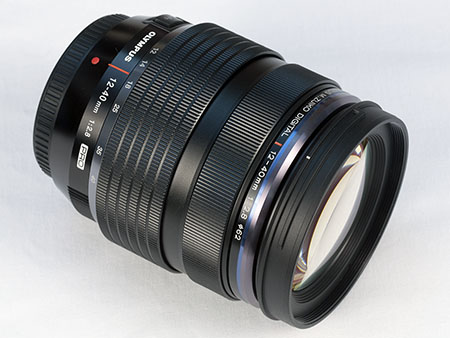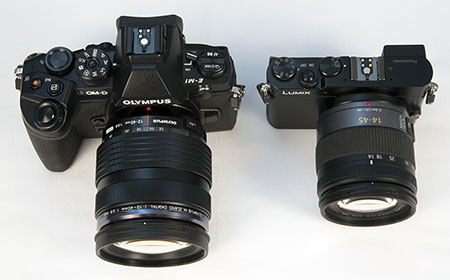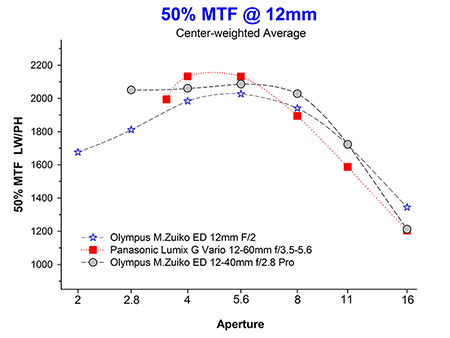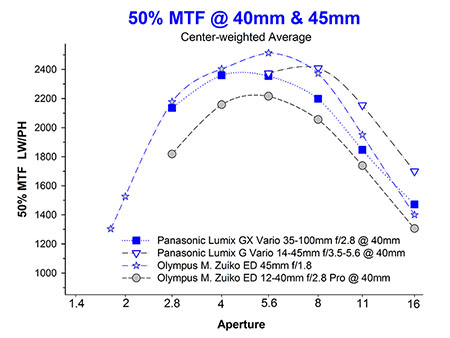Olympus M.Zuiko ED 12-40mm f/2.8 Pro Lens Review
These pages are still under review and undergoing revision.
This is a summary of performance evaluation tests that I ran on the Olympus M.Zuiko ED 12-40mm f/2.8 Pro lens for micro four thirds cameras. I have been using a Panasonic Lumix G Vario 14-45mm f/3.5-5.6 lens as my light weight general photography zoom lens and have been interested in a high quality zoom zoom in the 12-35mm range. I previously evaluated a Panasonic Lumix Vario G X 12-35mm f/2.8 lens and a Panasonic Lumix Vario G 12-60mm f/3.5-5.6 lens. There were sufficient shortcomings in these lenses as has been summarized in my reviews of the 12-35mm f/2.8 lens and the 12-60mm f/3.5-5.6 lens to warrant selling them. The Olympus M.Zuiko ED 12-40mm f/2.8 Pro lens has been available since 2013 and has received excellent reviews. I have been hesitant to acquire one because of the lens size and weight as well as the price. When Olympus bundled the lens with the OM-D E-M1 at a great price to reduce their E-M1 inventory with the introduction of the E-M1 Mark II, I succumbed and purchased the pair.
| Zoom Lens | Size | Weight |
| Olympus M.Zuiko ED 12-40mm f/2.8 Pro | 2.75x3.31 inches 69.9x84mm (62mm filter) |
13.47 oz 382 g |
| Panasonic Lumix G Vario 14-45mm f/3.5-5.6 | 2.36x2.36 inches 59.9x59.9mm (52mm filter) |
6.88 oz 195g |
MTF50 Results
MTF50 is a measure of lens sharpness. MTF50 performance was determined using Imatest Master v. 3.7 as described using a SFRplus Chart. A 13 region, center-weighted MTF50 value is posted below as well as center, mid-zone, and corners lens performance. Regions of analysis on the SFRplus chart are described HERE. Click on the graph images to see larger image files.
| Center Weighted Average 50% MTF | |
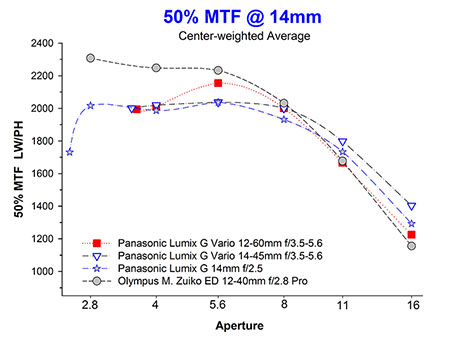 Center-Weighted Average MTF50 @ 14mm |
|
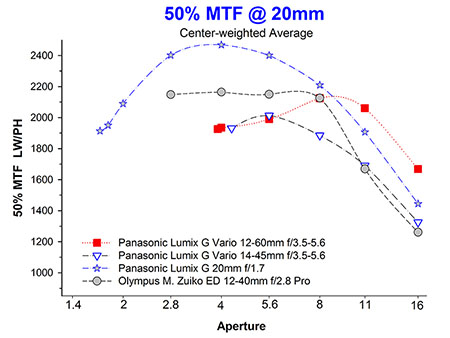 Center-Weighted Average MTF50 @ 20mm |
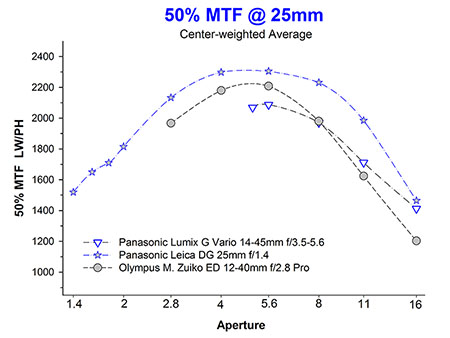 Center-Weighted Average MTF50 @ 25mm |
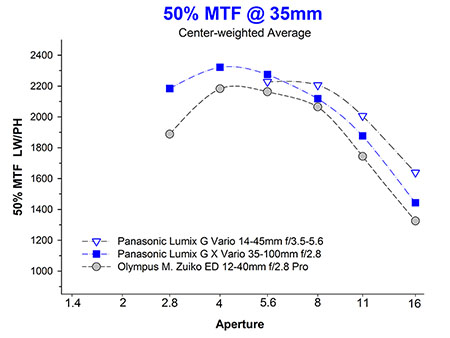 Center-Weighted Average MTF50 @ 35mm |
|
| |
|
| 50% MTF for Center, Mid-zone and Corners of Field: Prime Lenses Compared to Olympus 12-40mm f/2.8 Lens |
|
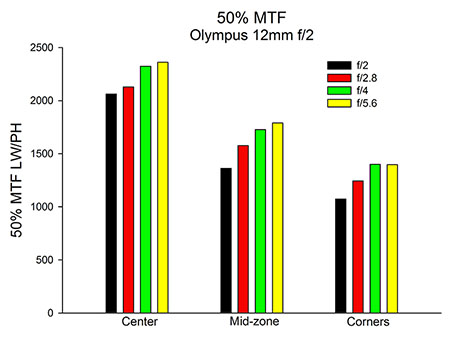 MTF50 Data at 12mm for Center, Midzone and Corners Olympus 12mm f/2 lens |
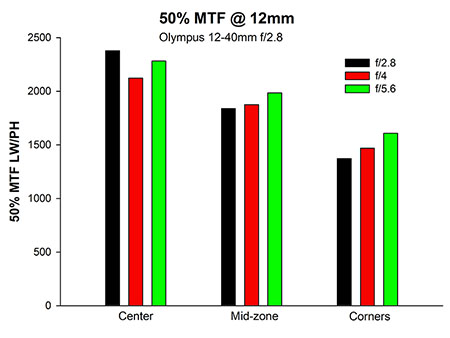 MTF50 Data at 12mm for Center, Midzone and Corners Olympus 12-40mm f/2.8 lens at 12mm |
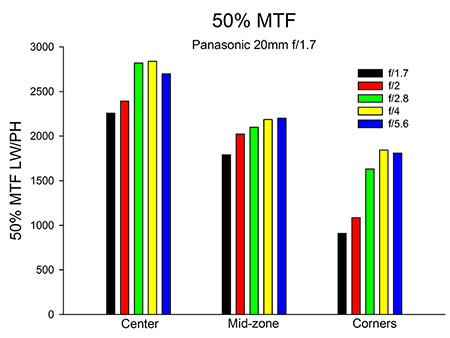 MTF50 Data at 20mm for Center, Midzone and Corners Panasonic 20mm f/1.7 lens |
 MTF50 Data at 20mm for Center, Midzone and Corners Olympus 12-40mm f/2.8 lens at 20mm |
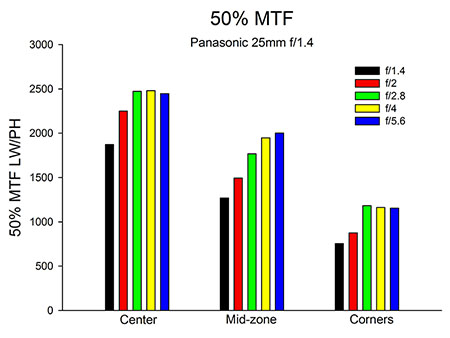 MTF50 Data at 25mm for Center, Midzone and Corners Panasonic Leica 25mm f/1.4 lens |
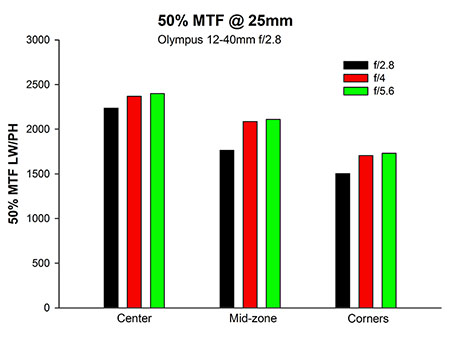 MTF50 Data at 25mm for Center, Midzone and Corners Olympus 12-40mm f/2.8 lens at 25mm |
Light Dropoff (Vignetting)
Light drop off
for the Olympus 12-40mm lens is most severe at 14mm at f/2.8 and also significant at f/2.8 at other focal lengths. Stopping the lens down reduces vignetting to a reasonable, but measurable level. Click on graph to display a larger image.
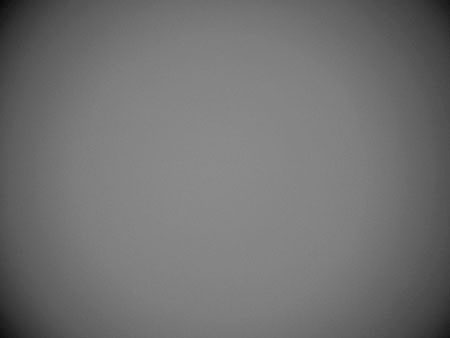 Vignetting of 12-40mm lens at 12mm, f/2.8 (1.5 EV) |
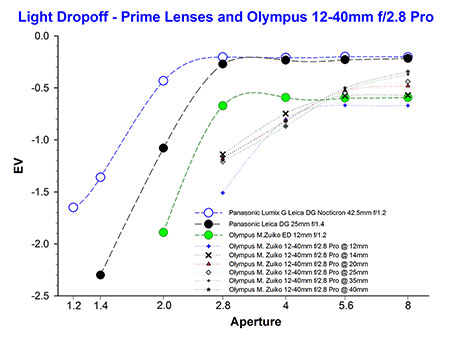 |
Chromatic Aberrations and Distortion
Imatest results indicate that the Olympus 14-40mm f/2.8 lens produces insignificant chromatic aberration..
The Imatest site indicates that CA values under 0.04% are insignificant. Values over 0.15% are classified as visible. Geometric distortion is negligible after processing RAW files out of either the OM-D E-M1 or the GX7.
| 12mm | 14mm | 20mm | 25mm | 40mm | |
| CA area % @ f/2.8 | 0.03 | 0.04 | 0.03 | 0.02 | 0.02 |
| Geometric Distortion | 0.07% barrel | 0.09% pincushion | 0.16% pincushion | 0.03% barrel | 0.04% barrel |
Photographic tests of the Olympus M.Zuiko ED 12-40mm f/2.8 Pro lens at 20mm, 25mm and 40mm Compared to Prime Lenses
Portrait Style Test at 25mm to assess out of focus blurring quality (bokeh)
Tests were run with a mannequin head 6 feet in front of a background. The focus point was the right eye of the mannequin. Aperture was closed enough to get sufficient depth of focus to get both eyes in focus at a working distance of 4.5 feet from the mannequin head for all images taken in this series. Lens design characteristics that influence the quality of out of focus blur (online references: Merklinger , van Walree and Atkins) include aperture (both f/stop setting and maximal lens opening size), aperture iris shape, and degree of spherical aberration correction. Click on images to get a larger image to inspect. Both the Olympus 12-40mm f/2.8 lens and a Panasonic 25mm f/1.4 lens were tested. Also, a 35mm format lens was tested, the Canon EF 50mm f/1.4 on an EOS-5 mark III for comparison of out of focus blurring.
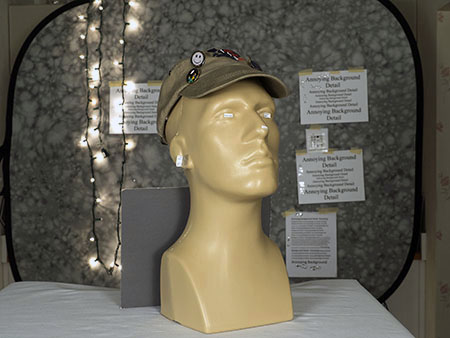 |
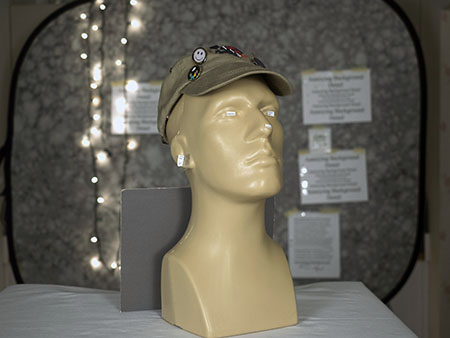 |
| f/8, Olympus M.Zuiko ED 12-40mm f/2.8 lens at 25mm Aperture of f/8 provides depth of focus adequate to assess the background detail. The background has monolights, text and USAF1951 test pattern. There are sequins on the paper in the background to provide out of focus specular light discs to assess bokeh quality. |
f/2.8, Olympus M.Zuiko ED 12-40mm f/2.8 lens at 25mm Aperture of f/2.8 provides mild background blurring and sufficient depth of field for facial features to be in focus. Out of focus specular light discs show generally even, diffuse blurring. Text is softly blurred. |
 f/2, Panasonic Leica 25mm f/1.4 lens Aperture of f/2 provides significantly more out of focus blurring of the background compared to f/2.8 while both eyes of the mannequin and other facial features are still in focus. For comparison: f/1.4, f/1.8, f/2.8 Image quality at f/1.8 is still very usable. At f/2.8, out of focus blurring is not quite a soft and diffuse as that produced by the Olympus 12-40mm lens at f/2.8. This may be due in part to the smaller overall lens diameter of the Panasonic lens requiring a 46mm filter compared to 62mm filter size on the larger diameter Olympus 12-40mm lens. |
 f/4, Canon EF 50mm f/1.4 lens on full-frame 35mm format EOS-5D mark III camera Out of focus blurring and depth of focus at f/4 on the full-frame 35mm format camera is roughly comparable to that produced at f/2 with the micro four thirds camera. The 8-blade diaphragm with straight edge blades provides octagonal out of focus light images of the diaphragm. The larger Canon sensor with 22.3 MP compared to the smaller 16MP sensor on the Olympus does make a difference in image quality. For comparison with the f/2.8 image with the micro four thirds images see: f/5.6 with the Canon camera. The above small image was cropped to four thirds format to fit the page. The larger image that is linked is full frame format dimensions. |
Portrait Style Test at 20mm to assess out of focus blurring quality (bokeh)
This series
was photographed at 3.5 feet from the mannequin to assess out of focus blurring at 20mm focal lenght.
 f/2.8, Olympus M.Zuiko ED 12-40mm f/2.8 lens at 20mm Quality of out of focus blurring (bokeh) is comparably good to that at 25mm with this lens. |
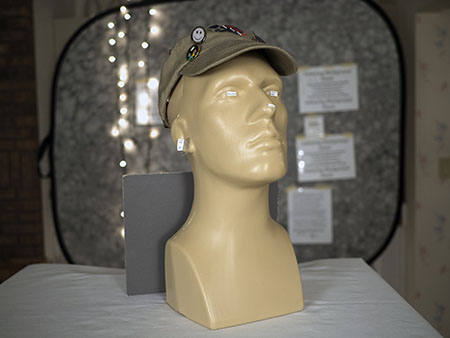 f/2, Panasonic Lumix 20mm f/1.7 lens Out of focus blurring is good, but there is uneveness in the out of focus specular light discs. Comparison image at: f/2.8 shows less even blurring of background compared to bokeh produced by the Olympus 12-40mm lens at 20mm and f/2.8. |
Portrait StyleTest at 40mm to assess out of focus blurring quality (bokeh)
Images taken at position 5 feet from the mannequin.
 f/2.8, Olympus M.Zuiko ED 12-40mm f/2.8 lens at 40mm Modest blurring of the backgroud. Out of focus specular light discs are unevenly illuminated with outer ring formation. Blurring of text at f/2.8 is poor compared to blurring provided by the Olympus 45mm prime at f/2.8 |
 f/1.8, Olympus M.Zuiko ED 45mm f/1.8 lens This high quality prime lens produces excellent blurring of the background with evenly illuminated out of focus specular light discs at f/1.8 with both eyes being in focus. Similar findings are visible in comparison images at: f/2, f/2.8 |
Summary of Findings with Olympus M.Zuiko ED 12-40mm f/2.8 Pro lens
This lens has outstanding MTF50 performance wide open from 12mm through 35mm focal lengths with no appreciable geometric distortion or chromatic aberration. It vignettes moderately at f/2.8, but this light drop off is largely corrected by stopping the lens down to f/4 or f/5.6. It produces very smooth out of focus blurring (bokeh) at 20mm and 25mm focal lengths. Details follow for focal lengths tested.
12mm
The Olympus M.Zuiko ED 12-40mm f/2.8 Pro lens has excellent MTF50 performance from center to corners at 12mm from f/2.8 to f/8 and performs better at f/2.8 than the Olympus 12mm f/2 prime lens tested. There is negligible geometric distortion and chromatic aberration. The lens has substantial vignetting at f/2.8 that is largely corrected by stopping the lens down to f/5.6. Any remaining vignetting can be easily corrected by processing RAW image files.
14mm
MTF50 performance at 14mm is better than that of any of the other 3 lenses that were tested including the Panasonic 14mm prime. It is sharpest at f/2.8. Vignetting at f/2.8 is less severe than that at 12mm. Light drop off is similarly largely corrected by stopping the lens down to f/4 or f/5.6
20mm
MTF50 performance at 20mm is excellent from f/2.8 to f/8 from center to corners. Vignetting at f/2.8 is comparable to that at 14mm and similarly corrected by stopping the lens down to f/4 or f/5.6. Quality of out of focus blurring (bokeh) is excellent and better at f/2.8 than bokeh producted by the very sharp Panasonic 20mm f/1.7 lens.
25mm
MTF50 performance and light-drop off characteristics at 25mm are similarly excellent to the lens performance at 20mm. The 12-40 lens has much better MTF50 performance in corners of the field than that of the Panasonic 25mm f/1.4 prime. Bokeh produced by the 12-40 lens at 25mm and f/2.8 is excellent and better than that produced by the Panasonic 25mm f/1.4 lens when stopped down to f/2.8. It is reasonable to speculate that this better bokeh by the zoom lens is at least in part due to its overall greater light path diameter requiring a 62mm lens filter whereas the narrower Panasonic prime has a filter diameter of 46mm. Other optical characteristics of the 12-40mm zoom presumably also contribute to the high quality out of focus blurring at 25mm.
35mm
At 35mm, MTF50 performance of the Olympus M.Zuiko ED 12-40mm f/2.8 Pro lens is still excellent, although performance at f/2.8 drops. However, the Panasonic Lumix G X Vario 35-100mm f/2.8 lens outperforms the Olympus 12-40mm lens at 35mm, and the much less expensive Panasonic Lumix G Vario 14-45mm f/3.5-5.6 lens appears to match MTF50 performance of the 12-40 zoom at 35mm focal length.
40mm
MTF50 performance at 40mm is similar to that at 35mm with a slight drop in performance at f/2.8. Stopping the lens to f/4.0 gives excellent MTF50 performance. Bokeh quality produced by the 12-40mm lens at 40mm is lower than that produced by the lens at 20 and 25mm.
Conclusion on the Olympus M.Zuiko ED 12-40mm f/2.8 Pro lens
This is a large and heavy 3X zoom lens with weather sealing for micro four thirds cameras that provides outstanding photographic imaging performance in the 12-40mm range. MTF50 performance is outstanding to excellent from center to corners in the f/2.8 to f/5.6 aperture range. There is negligible chromatic aberration and geometric distortion throughout the 12-40mm range when used with an OM-D E-M1 body. Light drop off is substantial at f/2.8. However, stopping the lens down to f/4 or f/5.6 reduces vignetting to an acceptable level. Out of focus blurring (bokeh) at f/2.8 is excellent in tests run at 20mm and 25mm. The quality of bokeh declines at the 40mm focal length.
Overall, this is an outstanding, weather-sealed lens in the 12-40mm range for micro four thirds cameras so long as you are willing to support the weight, size and cost of the lens.
posted 19 October, 2016, Updated 21 October 2016
© 2016, William L. Castleman
